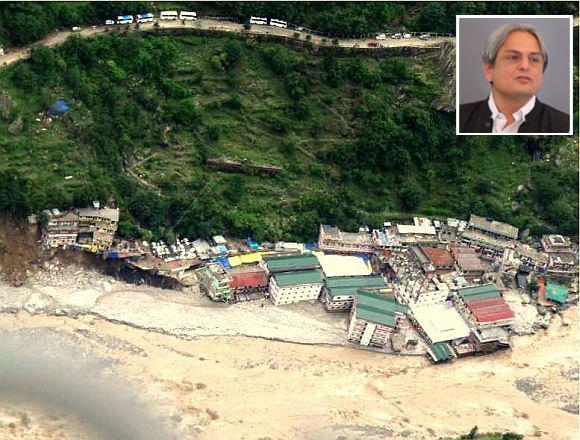 | « Back to article | Print this article |
'India may not be able to afford cost of flood relief soon'
As authorities undertake relief work in the flood-affected areas in Uttarakhand. where more than 100 people have lost their lives and thousands affected, experts analysing the situation say that flood management initiatives also point to the gap of not having faster, better and more effective ways of making damage and loss assessments after floods.
Mihir Bhatt, the founder of the All India Disaster Mitigation Institute, a community-based, action research and advocacy organisation that aims to bridge the gap between policy, practice and research in disaster risk management, tells rediff.com’s Vicky Nanjappa that the cost of not learning from our past experiences and not using our youthful national energies for innovating is plainly visible in the ongoing flood responses.
Are the floods in Uttarakhand a turning point in our history of disaster management?
We hope that with this flood, we in India seriously and systematically start learning from our experiences as well as start innovating for future responses. The cost of not learning from our past experiences and not using our youthful national energies for innovating is plainly visible in the ongoing flood responses.
The National Disaster Management Authority has made serious efforts to capture our national flood experience over the past decade or so in the form of preparing flood and urban flood guidelines.
Similarly, Bihar is in the process of developing a flood recovery model in the form of Koshi flood recovery project with the World Bank’s support. This model may be of great use to all flood-prone states in India.
Even districts such as Champaran and Madhubani in Bihar are unfolding participatory processes to involve flood victims in hazard mapping. Assam has initiated a review of its disaster management plans across all districts and four cities that face floods year after year.
These multi-level initiatives tell us that a lot is being done to better respond to floods and reduce the risk – yet, it is not enough. A lot more needs to be done in terms of our flood response to protect the economic growth and spread the fruits of social protection in various states in India.
Better and more flood sensitive village planning; construction of flood-proof shelters for all income groups; and flood protected investments in infrastructure are overdue. The said initiatives also point to the gap of countrywide insurance protection for flood victims and damaged private property and public assets across the major flood basins in India.
Repeated cost of flood relief may soon be too costly for India to afford.
Click NEXT to read further...
'Women and children suffer the most after the floods'
Large-scale ecosystem restoration across river basins, including plantation of diversity of vegetation, is also pointed out as a gap. The said flood management initiatives also point to the gap of not having faster, better and more effective ways of making damage and loss assessments after floods.
Losses suffered by the communities that migrate out due to floods are often unaccounted for. So are losses to women workers, tribal citizens and minority groups.
Loss of wages as well as assets suffered by the informal sector workers in cities and forests are hardly calculated for flood response. As a result, women and children suffer the most after the floods.
Most importantly, the flood response must be climate-smart. That is, the response must invest in the local capacity to adapt to build resilience to floods. State climate adaptation plans and disaster management plans cannot remain disconnected.
Why are the above gaps not filled?
First, there is need for a committed leadership within the government and in civil society that is addressing the need for better and faster flood response. Second, system-wise and sustained investments in flood risk reduction by the private sector are yet to come. Public investments are scattered and slow.
Indians are taking a range of actions in innovative ways to live with floods. Such innovations by officials and activists must be recognised and spread to the next district or the next state.
Where are such opportunities to benefit from the creativity of our own citizens? India must find a new generation of flood response to the floods in Uttarakhand. What is at stake is not only the recovery but the reputation of India's decade of flood preparedness.
TOP photo features of the week
Click on MORE to see another set of PHOTO features...


